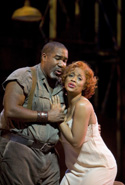 Sing the luxurious voice
Sing the luxurious voice
It’s a little known but not secret fact that bass-baritone Eric Owens is a killer Ping-Pong player. All those years backstage—waiting for technical crews, directors, costumers, repetitions of songs and scene changes, whatever—allow one to hone one’s reflexes while batting balls across that tabletop version of the tennis green.
So much for unsung skills; what’s very well known about Owens is that he is a singer of formidable talent and artistry with a powerful voice of complex warmth and profound richness. And this month he has brought that voice and artistry to the San Francisco Opera’s production of Porgy and Bess, giving the role of the crippled Porgy a melodic substance that was nearly palpable in its onstage presence.
Vocally, he was matched with Laquita Mitchell, dressed in orange satiny stuff and topped with a red wig—clearly production took the song “A red-headed woman” very seriously. She provided a sensual Bess, large-voiced and lusciously warm.
Two singers in whose voices the listener longs to linger and, well, wallow.
Music in every gesture
Although Gershwin’s Porgy and Bess is about compellingly melodic and memorable solos, the drama itself is about a milieu. The story of Porgy and Bess’ love, on some level, lacks credibility—Bess becomes Porgy’s lover out of necessity and good survival instincts, a reality that is borne out by her easy seduction by Sporting Life. What is more credible and more arresting in this longer version of the opera is the love affair’s background: the definitely-not-suburban Catfish Row neighborhood. Four people die here, two murdered, two drowned. And around those deaths are built the opera’s dramatic action and its enduring intelligence.
What this means musically, operatically, is that the chorus and the shorter solos take on an unusual emphasis. The chorus lived up to its task with elation. It had punch, vibrancy and electricity. Even during the more subdued moments—the wake for Brother Robbins and the drowning of Jake and Clara—this chorus rocked. And the shortest solos in this production were shaped with beauty and passion. Samantha McElhaney’s Strawberry Woman was exquisite, sung with a tonal clarity that was sweet and fresh and mouthwatering.
During the break, someone complained to me that he didn’t like the stage direction, but he liked the choreography. I’m not sure how he managed to separate the two. Directed and produced by Francesca Zambello, and realized in the SF Opera House by Rita D’Angelo Tikador with choreography by Denni Sayers, the staging requires lots of movement by everyone. In my mind, the action onstage was danced rather than performed. True, some characters were more stylized in their movement, and the marks of choreography more evident: every gesture made by Chauncey Packer’s Sporting Life was large, theatrical and designed. As a purveyor of dreams and drug-laced illusions, he rightly displayed artificiality in his movements and a reedy tenor; these amped up our pleasure by erasing our belief in the reality of a character who was otherwise despicable.
The sets by Peter J. Davison were modular, with two walls of scaffold-like doors and windows rising into the upper reaches of the stage and remaining more or less constant, while the trappings of skeletal rooms were moved in and out. The design was a little cold, a little lo-tech postmodern, and that strategy was repeated in the lighting, which seemed stark in its palette of blues and orange. The factory quality of it all made sense but was slightly at odds with the emotional warmth of the opera. Nevertheless, this is a great opera and an excellent production. One that should be seen. It’s good to remember, when you’re debating over buying tickets, that Porgy and Bess has been presented only three other times in the San Francisco Opera House’s long history.
—Jaime Robles
Originally published in the Piedmont Post
Photo: Eric Owens and Laquita Mitchell as Porgy and Bess. By Cory Weaver.
